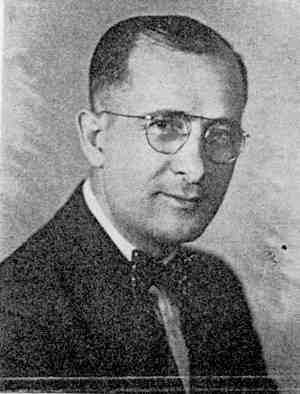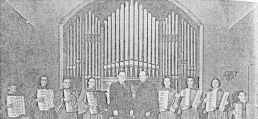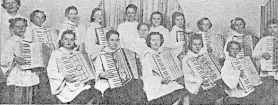The Free-Reed Journal
Articles and Essays Featuring Classical Free-Reed
Instruments and Performers
An Organist Convert
by Charles Bowen
This article was reprinted in its entirety from the
September 1937 issue of Accordion World (New York).
 It was a little more than twenty years
ago that the pipe organ was introduced in the American theater. At
that time "legitimate" organists were
loud in their denunciation of this
theatrical venture, for they thought
that if people wanted to hear organ
music they would go to a church for
it. The organ, however, proved tremendously popular with theatrical
audiences, and, as a result, organists
were in great demand—at salaries
ranging from $75.00 to $100.00 per
week. Gradually those who had felt
theater work beneath their dignity
began to see the situation in a different light. Many of them, though,
reconstructed their ideas too late, for
talking pictures and "canned" music
began once more to revolutionize
theatrical programs, and to take the
place of real musicians.
It was a little more than twenty years
ago that the pipe organ was introduced in the American theater. At
that time "legitimate" organists were
loud in their denunciation of this
theatrical venture, for they thought
that if people wanted to hear organ
music they would go to a church for
it. The organ, however, proved tremendously popular with theatrical
audiences, and, as a result, organists
were in great demand—at salaries
ranging from $75.00 to $100.00 per
week. Gradually those who had felt
theater work beneath their dignity
began to see the situation in a different light. Many of them, though,
reconstructed their ideas too late, for
talking pictures and "canned" music
began once more to revolutionize
theatrical programs, and to take the
place of real musicians.
And now a
new musical era is here—the era of
the Accordion. May I sound a note
of warning at this time to all pianists
and organists to get on the band
wagon? Studios all over the country
are clamoring for good teachers.
Both pianists and organists (especially organists) by virtue of their
previous musical training make ideal
teachers for this more modern instrument.
My own career has brought me in
close contact with these changing
conditions. Originally, I was a
church organist, but fortunately, I
had a prophetic feeling that the theater was a coming field for the organ,
and I was glad of an opportunity to
change to this field. The next ten
years were both busy and remunerative as I filled many theater and
radio engagements. Then with the
decline of theatrical work, I began
to consider other musical possibilities
to take its place, felt slightly
disdainful of it. However, one day
I was passing a music store, and seeing one in the window, my curiosity
was aroused. I went in; tried playing one, and had the basses explained
to me. Almost immediately I lost
my prejudice, for the accordion seemed nothing but an organ in a new
form. Ever since I have objected to
the name piano accordion because I
feel it in no way resembles a piano.
The piano keyboard is just as much
an organ keyboard.
Well, the result of my impulsive
stopping in the music store was the
purchase of an inexpensive instrument, which I immediately took home
and the next day spent four hours
playing. Two weeks later I made my
first appearance as a professional accordionist at the First President's Ball
to be held in Philadelphia, playing
with an orchestra of thirty pieces.
This was really the beginning of a
new career for me. Not only have
I been busy with radio and personal
engagements, but now have four
bands under my personal direction.
 Soon after starting to play the Accordion, I also began to give instruction to a class of six members. From
the first I conceived the idea of developing an organ chorus using four
part harmony. It also seemed to me
that the best idea for getting the
organ idea across to an audience was
to have the members of the group
dress in vestments. Four months
later I had my first vested group.
Today, we do a great deal of work
in churches, and when the chorus,
garbed in this manner, marches into
a church, playing a processional tune,
it is really inspiring. We also use
vestments very effectively in concert
work when playing such numbers as
"The Rosary," "Mighty Like a Rose",
etc.
Soon after starting to play the Accordion, I also began to give instruction to a class of six members. From
the first I conceived the idea of developing an organ chorus using four
part harmony. It also seemed to me
that the best idea for getting the
organ idea across to an audience was
to have the members of the group
dress in vestments. Four months
later I had my first vested group.
Today, we do a great deal of work
in churches, and when the chorus,
garbed in this manner, marches into
a church, playing a processional tune,
it is really inspiring. We also use
vestments very effectively in concert
work when playing such numbers as
"The Rosary," "Mighty Like a Rose",
etc.
 Connected with our Philadelphia
Studios we now have four bands; a
junior group, using twelve and forty-eight bass instruments ; the Camden
Chorus; the Philadelphia Organ
Chorus; and the Excelsior Organ
Chorus. Each of these groups I direct
personally once a week.
Connected with our Philadelphia
Studios we now have four bands; a
junior group, using twelve and forty-eight bass instruments ; the Camden
Chorus; the Philadelphia Organ
Chorus; and the Excelsior Organ
Chorus. Each of these groups I direct
personally once a week.
My change to the accordion was
quite a surprise to some of my fellow organists. Sometime ago, I
chanced to meet an acquaintance who
was an excellent organist, but who
was nevertheless not having much
opportunity to use his talents. He
asked where I had been, and when I
answered "Busy!" he could hardly
believe it. When I told him it was
with the accordion, he was very
amused and a little scornful. "It's
a good bet. Think it over." I told
him.
Recently he called me up to ask
more about it and today he is
teaching at our Philadelphia Studios.
As a result of my experience with
the organ, I have a somewhat different conception of how the accordion should be played from that of
a pianist or of a person who has had
no previous musical training. And
in another article, will give my theory
of how to take advantage of the
wonderful organ effects that may be
obtained with an accordion.
The Classical Free-Reed, Inc. staff gratefully acknowledges
volunteer Brian O'Boyle who assisted in
the production of this article, as well as Stanley Darrow and his
comprehensive American Accordion Musicological Society
library.
 It was a little more than twenty years
ago that the pipe organ was introduced in the American theater. At
that time "legitimate" organists were
loud in their denunciation of this
theatrical venture, for they thought
that if people wanted to hear organ
music they would go to a church for
it. The organ, however, proved tremendously popular with theatrical
audiences, and, as a result, organists
were in great demand—at salaries
ranging from $75.00 to $100.00 per
week. Gradually those who had felt
theater work beneath their dignity
began to see the situation in a different light. Many of them, though,
reconstructed their ideas too late, for
talking pictures and "canned" music
began once more to revolutionize
theatrical programs, and to take the
place of real musicians.
It was a little more than twenty years
ago that the pipe organ was introduced in the American theater. At
that time "legitimate" organists were
loud in their denunciation of this
theatrical venture, for they thought
that if people wanted to hear organ
music they would go to a church for
it. The organ, however, proved tremendously popular with theatrical
audiences, and, as a result, organists
were in great demand—at salaries
ranging from $75.00 to $100.00 per
week. Gradually those who had felt
theater work beneath their dignity
began to see the situation in a different light. Many of them, though,
reconstructed their ideas too late, for
talking pictures and "canned" music
began once more to revolutionize
theatrical programs, and to take the
place of real musicians.  Soon after starting to play the Accordion, I also began to give instruction to a class of six members. From
the first I conceived the idea of developing an organ chorus using four
part harmony. It also seemed to me
that the best idea for getting the
organ idea across to an audience was
to have the members of the group
dress in vestments. Four months
later I had my first vested group.
Today, we do a great deal of work
in churches, and when the chorus,
garbed in this manner, marches into
a church, playing a processional tune,
it is really inspiring. We also use
vestments very effectively in concert
work when playing such numbers as
"The Rosary," "Mighty Like a Rose",
etc.
Soon after starting to play the Accordion, I also began to give instruction to a class of six members. From
the first I conceived the idea of developing an organ chorus using four
part harmony. It also seemed to me
that the best idea for getting the
organ idea across to an audience was
to have the members of the group
dress in vestments. Four months
later I had my first vested group.
Today, we do a great deal of work
in churches, and when the chorus,
garbed in this manner, marches into
a church, playing a processional tune,
it is really inspiring. We also use
vestments very effectively in concert
work when playing such numbers as
"The Rosary," "Mighty Like a Rose",
etc. Connected with our Philadelphia
Studios we now have four bands; a
junior group, using twelve and forty-eight bass instruments ; the Camden
Chorus; the Philadelphia Organ
Chorus; and the Excelsior Organ
Chorus. Each of these groups I direct
personally once a week.
Connected with our Philadelphia
Studios we now have four bands; a
junior group, using twelve and forty-eight bass instruments ; the Camden
Chorus; the Philadelphia Organ
Chorus; and the Excelsior Organ
Chorus. Each of these groups I direct
personally once a week.